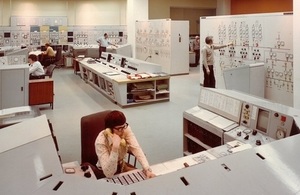Wylfa closes after almost 45 years
Wylfa, the last Magnox power station in the world, closed today after generating electricity for 5 years longer than originally planned.

The control room at Wylfa power station in the 1970s
The Anglesey power station was the last and largest in a fleet of 11 UK plants based on the ground-breaking Magnox design that gave the nation’s scientists a global lead in the race to develop nuclear energy for homes and businesses.
Back in 1956, the nation had celebrated the beginning of a new atomic age when the Queen opened the very first Magnox plant, Calder Hall in Cumbria. Its 190MW output was enough for 200,000 homes.
When Wylfa opened in 1971, it generated 1,000MW – enough for 40% of Wales’ total electricity needs – and was the most powerful nuclear power station in the world.
Almost 45 years later, staff gathered to mark the Reactor One switch-off, which follows 3 years after Reactor Two closed. The 5 years of extended life were only possible thanks to an innovative method of transferring partly used fuel from one reactor to the other. The manufacture of Magnox fuel had ceased in 2008.
Site Director Stuart Law said:
Today marks a safe and dignified end to the generation of electricity at Wylfa, and indeed for Magnox, and I am proud to say that I was a part of it.
Wylfa was originally due to shut in 2010 but the pioneering Inter-Reactor Fuel Transfer, or IRX process, was endorsed by the regulators and enabled another 5 years of operations.
The combined additional revenue from Wylfa’s extra lease of life, as well as from Oldbury’s 4-year extension, amounted to approximately £1 billion which has been used for decommissioning and clean-up.
The NDA’s Chief Executive John Clarke said:
I am proud of the team’s innovative work which made this extended operational life possible, but the time has come to finally switch her off and move into the decommissioning phase.
Fuel rods are already being removed from Reactor Two and dispatched to Sellafield for reprocessing. Defuelling of Reactor One will begin during early summer 2016, with a target for the site to be fuel free by late 2018. Full-scale decommissioning will last several decades.